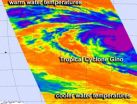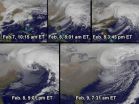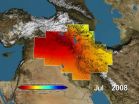(Press-News.org) Ants are just about everywhere you look, and yet it's largely unknown how they manage to be so ubiquitous. Scientists have understood the carnal mechanism of ant reproduction, but until now have known little of how successful the daughters of a colony are when they attempt to found new colonies.
For the first time, Stanford biologists have been able to identify specific parent ants and their own children in wild ant colonies, making it possible to study reproduction trends.
And in a remarkable display of longevity, an original queen ant was found to be producing new ants several decades after mating, sending out daughter queens throughout her 20- to 30-year lifespan.
"Most animals produce offspring for a while, and then they enter a life stage where they don't," said Deborah Gordon, a biology professor at Stanford and a senior fellow at the Stanford Woods Institute for the Environment. "These queen ants are mating once, storing that sperm in a special sac, keeping it alive and using it to fertilize eggs for another 25 years."
From an ecological viewpoint, an ant colony is much like a tree putting out seeds, with the potential to create new trees. An ant queen produces genetically identical worker ants that live in the same colony, and also produces sons, and daughter queens. The daughter queens, after mating, establish new colonies of their own.
Gordon has been studying a particular population of harvester ant colonies in southeastern Arizona for 28 years, meticulously recording when a new colony rises or an older one falls.
Gordon's group took the DNA fingerprint of each colony by analyzing a section of microsatellite, or "junk", DNA to identify which colonies were related. By pairing the genetic analysis with the long-term observations, Gordon was able to determine the original queen and colony, and the order in which the daughter queens and subsequent generations established new colonies.
The researchers also found that only about 25 percent of the colonies reproduce at all, and many of the daughter queens are not successful. The entire population – the study group consisted of about 300 colonies – relies on just a few queens to make most of the offspring year after year.
"We don't know whether all harvester ant populations always behave this way, or whether these trends hold true for all 11,000 ant species, because nobody has identified colony offspring before," Gordon said. "This gives us new insight on how ant populations change over time."
In general, ants play an important role in agriculture around the world, with some helping to disperse seeds while others eat herbivorous insects. Understanding how populations of ant colonies reproduce and expand, and the rate at which they do so, could be useful in managing invasive ant species, predicting crop yields and understanding the ecology of tropical forests.
"If you're trying to understand how a population grows – say, you are trying to keep a population of lions going – the first thing you need to know is how many lionesses you have, and how many cubs they have and can support per year," Gordon said. "For ecological purposes, it's very useful to be able to say how ant populations will grow. This is the first step toward understanding how to predict numbers of ant colonies."
###
The study was published Jan. 31 in the online version of the Journal of Animal Ecology.
Stanford scientist uncovers the reproductive workings of a harvester ant dynasty
2013-02-13
ELSE PRESS RELEASES FROM THIS DATE:
Major clinical trial finds no link between genetic risk factors and 2 top wet AMD treatments
2013-02-13
SAN FRANCISCO – February 12, 2013 – New findings from a landmark clinical trial show that although certain gene variants may predict whether a person is likely to develop age-related macular degeneration (AMD), a potentially blinding eye disease that afflicts more than nine million Americans, these genes do not predict how patients will respond to Lucentis™ and Avastin™, the two medications most widely used to treat the "wet" form of AMD. This new data from the Comparison of AMD Treatment Trials (CATT), published online in Ophthalmology, the journal of the American Academy ...
Explosive breakthrough in research on molecular recognition
2013-02-13
Edmonton—Ever wonder how sometimes people still get through security with explosives on their person? Research done in the University of Alberta's Department of Chemical and Materials Engineering has revealed a new way to better detect these molecules associated with explosive mixtures.
A team of researchers including post-doctoral fellows Seonghwan Kim, Dongkyu Lee and Xuchen Liu, with research associate Charles Van Neste, visiting professor, Sangmin Jeon from the Pohang University of Science and Technology (South Korea), and Department of Chemical and Materials Engineering ...
Lower autism risk with folic acid supplements in pregnancy
2013-02-13
Women who took folic acid supplements in early pregnancy almost halved the risk of having a child with autism. Beginning to take folic acid supplements later in pregnancy did not reduce the risk. This is shown in new findings from the ABC Study and Norwegian Mother and Child Cohort Study published in the Journal of The American Medical Association (JAMA).
Women who took folic acid supplements from four weeks before conception to eight weeks into pregnancy had a 40 per cent lower risk of giving birth to children with childhood autism (classic autism). Use of folic acid ...
NASA sees Cyclone Gino wind up to wind down later
2013-02-13
NASA's Aqua satellite passed over Cyclone Gino as the storm continues to wind up in the southern Indian Ocean, consolidating and strengthening. Infrared data shows the storm has strengthened but it is headed for cooler waters which will weaken it in coming days.
On Feb. 12 at 0841 UTC, NASA Atmospheric Infrared Sounder (AIRS) instrument that flies aboard the Aqua satellite captured infrared imagery of Cyclone Gino that showed the storm developed a large area of very cold, high cloud top temperatures around its center indicating powerful thunderstorms. Cloud top temperatures ...
NASA provides satellite views of nor'easter lifespan
2013-02-13
NASA and NOAA satellites have provided animations and images of the coupling of two low pressure areas that created the now historic winter-time nor'easter that brought more than two feet of snow to portions of the New England states on Feb. 8 and 9, 2013. NASA released an animation of NOAA satellite imagery that shows the lifetime of the historic nor'easter.
The nor'easter dropped between 2 and 3 feet of snowfall over the U.S. Northeast and left more than 650,000 without power in eight states, according to the Associated Press. Several governors established travel bans ...
NASA satellites find freshwater losses in Middle East
2013-02-13
A new study using data from a pair of gravity-measuring NASA satellites finds that large parts of the arid Middle East region lost freshwater reserves rapidly during the past decade.
Scientists at the University of California, Irvine; NASA's Goddard Space Flight Center in Greenbelt, Md.; and the National Center for Atmospheric Research in Boulder, Colo., found during a seven-year period beginning in 2003 that parts of Turkey, Syria, Iraq and Iran along the Tigris and Euphrates river basins lost 117 million acre feet (144 cubic kilometers) of total stored freshwater. That ...
Gaps in mental health infrastructure for youth identified in many US communities
2013-02-13
ATLANTA- Mental health facilities that provide outpatient specialty services for youth are a critical element of the mental health care infrastructure, especially for youth who are uninsured or publically insured.
In a Viewpoint article in the February 13 issue of JAMA, Janet Cummings, PhD, assistant professor of health policy and management at Emory's Rollins School of Public Health, presents data from the 2008 National Survey of Mental Health Treatment Facilities and examines the extent to which gaps exist in the mental health treatment system for youth.
Based ...
In some dystonia cases, deep brain therapy benefits may linger after device turned off
2013-02-13
LOS ANGELES (Feb. 12, 2013) – Two patients freed from severe to disabling effects of dystonia through deep brain stimulation therapy continued to have symptom relief for months after their devices accidentally were fully or partly turned off, according to a report published online Feb. 11 in the journal Movement Disorders.
"Current thought is that symptoms will worsen within hours or days of device shut-off, but these two young men continued to have clinical benefit despite interruption of DBS therapy for several months. To our knowledge, these two cases represent the ...
Novel test streamlines testing for Huntington Disease
2013-02-13
Philadelphia, PA, February 13, 2013 – A new test may help to streamline genetic testing for Huntington Disease (HD) by generating accurate results, avoiding unnecessary additional testing, and improving turnaround time. The test, which uses chimeric or triplet repeat primed PCR (TP PCR) methodology, yielded results that were 100% concordant with standard genotyping methods in an analysis of 246 samples. The high sensitivity and specificity of the test could reduce the number of false negative results and facilitate both diagnosis and prognosis by correctly sizing the genetic ...
Scientists should advance management of behavioral norms
2013-02-13
Researchers should study how people's social and personal norms are influenced by behavior and use their insights to help governments promote pro-environmental actions, a distinguished group of scholars writes in the March issue of BioScience. The authors maintain that effective policies induce not only short-term changes in behavior but also long-term changes in norms. More effective management of social norms will be necessary, they write, to persuade the public to accept the inconvenience and expense of many environmental policies.
The interdisciplinary group, led by ...


